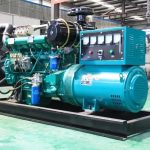Introduction

Diesel generators play a crucial role in providing backup power during emergencies or in off-grid locations where access to the main power grid is limited. These reliable sources of energy are essential for ensuring continuous operations in various industries such as healthcare, telecommunications, data centers, and manufacturing. However, like any mechanical system, diesel generators are prone to faults and failures that can disrupt their performance. Detecting and diagnosing faults in diesel generators is essential to prevent costly downtime and ensure the reliability of these critical power sources.
This article explores the importance of fault detection in diesel generators and the various methods and technologies available for improving reliability and performance.
Importance of Fault Detection in Diesel Generators
Fault detection in diesel generators is crucial for several reasons:
1. Preventing Downtime: Unexpected failures in diesel generators can lead to costly downtime, affecting critical operations and services. By detecting faults early, maintenance can be scheduled proactively to prevent unplanned outages.
2. Ensuring Reliability: Diesel generators are relied upon to provide backup power during emergencies. Detecting faults and addressing them promptly ensures that the generator will perform as expected when needed.
3. Extending Lifespan: Regular maintenance and fault detection can help extend the lifespan of diesel generators, reducing the need for costly replacements and downtime.
4. Safety: Faulty diesel generators can pose safety risks, such as fire hazards or emissions of harmful gases. Detecting faults early can help mitigate these risks and ensure a safe operating environment.
Methods for Fault Detection in Diesel Generators
There are several methods and technologies available for detecting faults in diesel generators, ranging from manual inspections to advanced monitoring systems. Some common methods include:
1. Visual Inspection: Regular visual inspections of diesel generators can help identify signs of wear, leaks, or other visible issues that may indicate a fault. Visual inspections should be conducted as part of routine maintenance procedures.
2. Acoustic Monitoring: Acoustic monitoring systems use sensors to detect abnormal sounds or vibrations in diesel generators, which can indicate mechanical issues such as bearing wear or misalignment. By analyzing the acoustic signals, faults can be detected early before they escalate.
3. Vibration Analysis: Vibration analysis involves monitoring the vibration levels of various components in a diesel generator to detect abnormalities that may signal impending failures. Changes in vibration patterns can indicate issues such as unbalanced rotors or misalignment.
4. Oil Analysis: Regular oil analysis can provide insights into the condition of the diesel generator's internal components, such as the engine, bearings, and seals. Contaminants or abnormal wear particles in the oil can indicate potential faults that require attention.
5. Thermal Imaging: Thermal imaging cameras can detect hotspots or abnormal temperature patterns in diesel generators, which may indicate issues such as overheating components or poor cooling system performance. By identifying thermal anomalies, faults can be diagnosed early.
6. Electronic Monitoring Systems: Advanced electronic monitoring systems can continuously monitor various parameters of a diesel generator, such as temperature, pressure, fuel levels, and emissions. These systems can provide real-time alerts and data for predictive maintenance and fault detection.
7. Data Analytics: Data analytics tools can analyze the vast amounts of data collected from diesel generators to identify patterns, trends, and anomalies that may indicate faults or performance issues. By leveraging machine learning algorithms, predictive maintenance strategies can be implemented to prevent failures proactively.
Challenges and Considerations
While fault detection technologies offer significant benefits for diesel generators, there are challenges and considerations to keep in mind:
1. Cost: Implementing advanced fault detection systems can involve upfront costs for equipment, sensors, and software. However, the long-term benefits in terms of reduced downtime and maintenance costs often outweigh the initial investment.
2. Training and Expertise: Proper training and expertise are essential for effectively implementing and interpreting data from fault detection technologies. Operators and maintenance personnel should be adequately trained to utilize these systems efficiently.
3. Integration with Maintenance Practices: Fault detection systems should be integrated seamlessly with existing maintenance practices to ensure that identified faults are addressed promptly. Establishing clear workflows and protocols for responding to fault alerts is essential for maximizing the effectiveness of these technologies.
4. Scalability: As the size and complexity of diesel generator systems vary across different applications, fault detection solutions should be scalable to accommodate the specific needs of each installation. Flexibility in system design and configuration is crucial for ensuring optimal performance.
Case Studies and Success Stories
Several industries have successfully implemented fault detection technologies for diesel generators, resulting in improved reliability and performance. Here are a few notable case studies:
1. Healthcare Facilities: Hospitals and healthcare facilities rely on diesel generators to maintain essential services during power outages. By implementing real-time monitoring systems that detect faults early, healthcare facilities can ensure uninterrupted power supply for critical equipment and patient care.
2. Telecommunications Networks: Telecommunications companies use diesel generators to power cell towers and communication infrastructure in remote locations. By utilizing acoustic monitoring and data analytics, telecom operators can predict and prevent generator failures, minimizing service disruptions.
3. Data Centers: Data centers require reliable backup power to prevent data loss and maintain operations during power failures. By integrating 50kw diesel generator for remote mining sites and vibration analysis tools, data center operators can proactively identify and address faults in diesel generators, ensuring continuous uptime.
Conclusion
Fault detection in diesel generators is essential for ensuring reliable backup power and preventing costly downtime. By leveraging a combination of methods such as visual inspection, acoustic monitoring, vibration analysis, and data analytics, operators can detect faults early and address them proactively. Implementing advanced fault detection technologies can improve the reliability, performance, and safety of diesel generators across various industries, leading to enhanced operational efficiency and reduced maintenance costs. As the demand for backup power solutions continues to grow, investing in fault detection systems for diesel generators will be crucial for maintaining continuous operations and ensuring business continuity.
